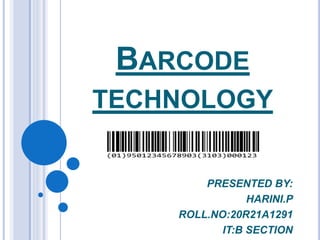
BARCODE TECHNOLOGY.pptx
- 2. CONTEXT: What is Barcode? How do barcodes work? Why do we use Barcodes? Barcode types. Evolution of barcodes. Barcode Scanner. Advantages of Barcodes. Disadvantages of Barcodes. Conclusion.
- 3. WHAT IS BARCODE? A barcode or bar code is a method of representing data in a visual, machine-readable form. Initially, barcodes represented data by varying the widths and spacings of parallel lines. These barcodes, now commonly referred to as linear or one-dimensional (1D), can be scanned by special optical scanners, called barcode readers. Barcode stores product related data like the date of manufacturing, expiry date, name of the manufacturer, country of the origin and price quantity of the product.
- 4. There are two types of barcode one is 1D and other is 2D (2 dimensional). “1 D” barcode is used in the normal products like groceries, pen, and electronic equipments etc. “2D” is similar to 1-dimensional barcode, but it can store more data per unit area as compared to the 1D. You must have seen the use of 2D barcode in the Paytm App.
- 5. HOW DO BARCODES WORK? As we know that a barcode is a square or rectangular image consisting of a series of parallel black lines and white spaces. The information is encoded between the length of each shaded line and the space between them. A scanning device uses a laser to "read" the bar code by scanning in the unique bar of shaded lines. A barcode scanner reads the lines from left to right.
- 6. A barcode scanner reads pattern of black and white bars which turns the information in the binary code (0 or 1). Computer reads the information in the binary forms only and same is displayed on the screen of the monitor. The "number" written in the right hand side of the "center guard" informs about the type of the product whether it is made of plastic or by natural things, vegetarian or non-vegetarian.
- 7. Now let us know that what barcode is assigned to different countries of the world: 1. India: 890 2. United States and Canada: 00 -13 3. France: 30-37 4. Germany: 40-44 5. Japan: 45-49 6. Russia: 46 7. Taiwan: 471 8. Sri Lanka: 479 9. Philippines: 480 11. Hong Kong: 89 12. United Kingdom: 50 13. China: 690-692
- 8. WHY DO WE USE BARCODES? Barcodes are widely used around the world in many contexts. In stores, UPC barcodes are pre-printed on most items other than fresh produce from a grocery store. This speeds up processing at check-outs and helps track items and also reduces instances of shoplifting involving price tag swapping, although shoplifters can now print their own barcodes. At the point of sale, shoppers can get product discounts or special marketing offers through the address or e-mail address provided at registration.
- 9. In addition, retail chain membership cards use barcodes to identify customers, allowing for customized marketing and greater understanding of individual consumer shopping patterns. Barcodes are widely used in the healthcare and hospital settings, ranging from patient identification (to access patient data, including medical history, drug allergies, etc.) They are also used to facilitate the separation and indexing of documents that have been imaged in batch scanning applications, track the organization of species in biology, and integrate with in- motion checkweighers to identify the item being weighed in a conveyor line for data collection.
- 10. EVALUATION OF BARCODES. One of the most common tools used for reading barcodes is the hand held barcode scanner. All of the barcode scanners recommended and sold by ID Automation have built-in decoders that can read several different bar code types. Most of the scanners sold by ID Automation receive their power from the PC keyboard or USB port so no external power supply is required. When a barcode is scanned, the data is sent to the PC as if it was typed using a keyboard.
- 11. BARCODE SCANNER
- 12. ADVANTAGES OF BARCODES Following are the benefits or advantages of Barcode: ➨It allows realtime data to be collected accurately and rapidly with the help of barcode readers. ➨It enables fast data entry operations with less errors. ➨It is mature and proven technology. ➨It is less expensive.
- 13. DISADVANTAGES OF BARCODES Following are the disadvantages of Barcode: ➨Barcode scanning requires special device called Barcode scanner which emits light and collects reflected light to decode the Barcode. ➨Barcode scanner or reader works with computers or POS terminals. ➨Barcodes do not have read/write capabilities. ➨It is labour intensive as it requires to be scanned individually. ➨It is susceptible to environmental damage. ➨scratched or crumpled barcodes may cause problems while scanning.
- 14. CONCLUSION Barcodes have slowly become an essential part of modern civilization. Their use is widespread, and the technology behind barcodes is constantly improving. Some modern applications of barcodes include: Almost every item purchased from a grocery store, department store, and mass merchandiser has a UPC barcode on it. This greatly helps in keeping track of a large number of items in a The tracking of item movement, including rental cars, airline luggage, nuclear waste, mail and parcels. Entertainment event tickets can have barcodes that need to be validated before allowing the holder to enter sports arenas, cinemas, theatres, fairgrounds, transportation etc. This can allow the proprietor to identify duplicate or fraudulent tickets more easily
- 15. THANK YOU! HAVE A GREAT DAY!